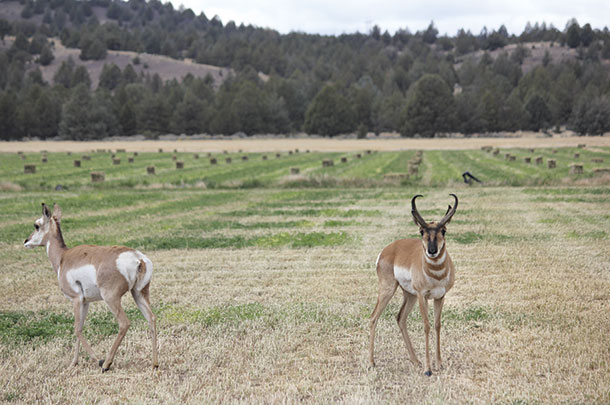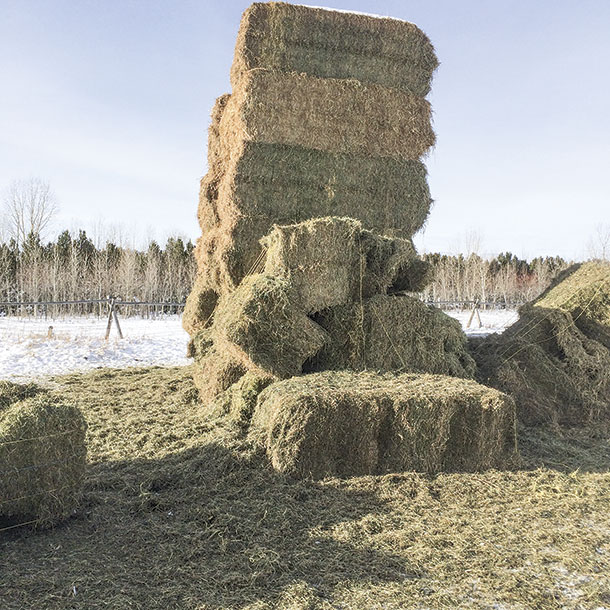Every winter, countless elk, deer and antelope descend from the hills and mountains to poach on haystacks.
Scott Cotton, extension educator with the University of Wyoming, says if it’s a winter following a heavy drought, especially in an area close to critical wildlife habitat, producers can expect more trouble than usual from wildlife.
“Most producers I work with in Wyoming, Colorado and Nebraska have issues usually in the winter and in areas close to key habitat areas,” Cotton says. “When you have a stack of hay standing there, it’s quite a benefit to them to eat that hay, which is in direct competition with your ability to carry your livestock through the winter.”
Duston Cureton, landowner/sportsman coordinator for the Idaho Department of Fish and Game’s Upper Snake region, says elk are creatures of habit, so some of the reasons for their depredation stems from their habitual behavior in the winter.
“In many winter depredation situations, adequate forage has been available in higher elevations but, because of past elk behavior and learned habits, elk seek out lower elevations looking for easy food, which is usually haystacks,” he says.
Disease and damage
There is a risk of transmission of diseases like brucellosis when elk come onto cattle feeding ground. “If you have an elk herd with issues that could potentially impact your livestock, then if they’re mingling on the same feeding ground and dropping manure on the same feedgrounds, there may be potential issues with the livestock becoming infected,” Cotton says.
Elk inflict more damage than simply eating hay meant to sustain livestock through the winter. If given free rein, they tear up haystacks and make what hay they don’t eat unusable.
“Elk have a tendency not just to eat what they need but to climb up on the bales and break them, so the next snowstorm you get, there’s a lot of damage to the hay because the integrity of the bales is compromised,” Cotton says. “You can’t transport it very easily after the bales are broken.”
Permanent fencing
The best defense against pressure from wildlife is fencing haystacks before winter sets in. “Permanent stackyards are our long-term solution for many landowners who have chronic issues,” Cureton says. These compounds can be sized to suit the producer to hold any amount of hay.
The entire stackyard is fenced with 8-foot netted wire and usually 7-foot gates. Cotton advises leaving a 20-foot margin between any stack edge and the fence so the elk will not be able to lean on the fence and try to reach over, plus plenty of space for trailers and equipment to maneuver.
 Permanent stackyards may be expensive to build, but the longevity and security might well be worth it to some producers.
Permanent stackyards may be expensive to build, but the longevity and security might well be worth it to some producers.
“If you’re looking at a stackyard that would hold maybe 100 tons of hay, your investment for the first year would be several thousand dollars, but the durability of a permanent stackyard, if you built it well and maintained it, would probably be 10 or 12 years, so if you appropriated it over that length of time, it’s not that bad,” Cotton says. Cureton says with good maintenance, a permanent stackyard could last up to 20 years.
Mobile fencing
For situations where a permanent stackyard is not feasible or where temporary fencing is required, steel panels are a more practical option. Cotton says while the heavier-grade – and therefore more durable – steel panels are more expensive, they are easily repurposed throughout the year for anything from setting up temporary pens for cattle to protecting a garden.
Cureton says 7x16 steel panels interspersed with 4x8 brace panels make a more stable fence that’s harder for elk to break through.
Jason Beck, landowner/sportsman coordinator for the Idaho Department of Fish and Game’s Southeast region, says being proactive is the best defense against wildlife depredations. “The more snow you have on the ground before you call and ask for the panels, the harder it is to get those set up in a way that they won’t get pushed over.
Proactive is the best approach by far.” Beck says last winter, in just the Southeast region, the department provided approximately 15 miles of temporary fencing. He says they have chronic wildlife problems in the winter in that area, so there are 7x16 panels stockpiled in several locations throughout the area so they are ready when winter comes.
Other alternatives for keeping wildlife out of haystacks include covering stacks with hay tarps or Tensar Geogrid, a tough, black plastic netting normally used in road construction. “Many landowners will completely tarp their stacks,” Cureton says. “We’ve found that’s a real good deterrent in most years.”
He says if they are determined enough, elk will chew through the tarps or Tensar to reach the hay or tear through it with antlers and hooves.

He says the important thing is to not let elk or other wildlife get the first taste of the haystack. “If it’s completely tarped, most of the time they’ll walk right past it and look for something else,” he says. “Once they’ve had a taste of hay, it’s really tough to keep them out of it.”
Cureton says elk can even be selective about which stacks they bother. “Elk have a keen nose for which hay is better,” he says. “Most of the time, they’ll hit third-crop hay first. Even if there’s second-crop or first-crop available, they will usually go for the third-crop first.
Third-crop hay is the most appealing, so that’s what we try to emphasize to landowners, that they’ve got to get that third-crop hay protected or moved because that’s the first thing the elk will try to hit.”
Tips and tricks
- Stack 1-ton straw bales two deep around the outside of the haystack. Cureton says elk won’t eat straw, so if you have easy access to straw, this is a good option.
- If you must use electric fence, rub the wires down with peanut butter. The peanut butter draws the attention of the deer, and they will lick the fence. “Once they’ve licked the fence and gotten shocked a few times, it makes a big mental image, so they don’t go close to it,” Cotton says.
- Don’t bother with lights and noise-makers. From lights and music to guard dogs and propane bombs, once wildlife get used to such disturbances, they ignore them.
Other more aggressive methods include hazing, driving wildlife away by shooting cracker shells (exploding shotgun shells) or hunting. Hunting levels can be adjusted, and special permits can be issued if wildlife pressure is too strong.
Laws regarding hunting and hazing of wildlife vary by state, so check with your local wildlife agency about the rules for your region. ![]()
PHOTO 1: Cureton says elk are the biggest wildlife problem producers in his region deal with in the winter. Photo provided by Duston Cureton.
PHOTO 2: Elk, deer and antelope are also a problem during the growing seasons when they graze on fields in production. Photo by Lynn Jaynes.
PHOTO 3: Elk-damaged haystacks can be a safety hazard as well as a serious loss of livestock feed. Photo provided by Duston Cureton.

-
Carrie Veselka
- Associate Editor
- Progressive Forage
- Email Carrie Veselka











